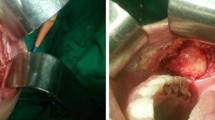Abstract
Buccal mucosa is one of the common subsite for oral carcinoma. Following excision of the buccal mucosa tumor mass various pedicled and free flaps have been used to reconstruct the oral cavity defect. In this age of free flaps various locoregional pedicled flaps have been underrated and overlooked and supraclavicular flap is one of them. This flap meets the functional and cosmetic acceptance of the buccal mucosa defect reconstruction with minimal morbidity to the donor site. This paper presents author’s experience of using supraclavicular flap in 10 patients of carcinoma buccal mucosa. In all cases surgical defect was completely covered by the flap, there was no necrosis of the flap. Functional and cosmetic outcome was acceptable in all the patients without compromising oncological clearance.





Similar content being viewed by others
Abbreviations
- PMMC:
-
Pectoralis major myocutaneous
- LD:
-
Lattismus Dorsi
References
Shah JP, Gil Z (2009) Current concepts in the management of oral cancer–surgery. Oral Oncol 45:394–401
Conway DI, Petticrew M, Marlborough H, Berthiller J, Hashibe M, Macpherson LMD (2008) Socioeconomic inequalities and oral cancer risk: a systematic review and meta-analysis of case control studies. Int J Cancer 122(12):2811–2819
Ashok Shenoy VS, Patil BS, Prithvi P, Chavan R (2013) Halkud, Supraclavicular Artery Flap for Head and Neck Oncologic Reconstruction: An Emerging Alternative, International Journal of Surgical Oncology, vol. Article ID 658989, 5 pages, 2013. https://doi.org/10.1155/2013/658989
Pallua N, Noah EM (2000) The tunneled supraclavicular island flap: an optimized technique for head and neck reconstruction. Plast Reconstr Surg 105(3):842–885
Lamberty BG (1979) The supra-clavicular axial patterned flap. Br J Plast Surg 32:207–201
Pallua N, Machens HG, Rennekampff O, Becker M, Berger A (1997) The fasciocutaneous supraclavicular artery island flap for releasing postburn mentosternal contractures. Plast Reconstr Surg 99(7):1878–1884
Ross RJ, Baillieu CE, Shayan R, Leung M, Ashton MW (2014) The anatomical basis for improving the reliability of the supraclavicular flap. J Plast Reconstr Aesthet Surg 67(2):198–204
Mathes SJ, Vasconez LO (1978) The cervico-humeral flap. Plast Reconstr Surg 61:7
Urken ML (1995) Trapezius system. In: Urken ML et al (eds) Atlas of regional and free flaps for head and neck reconstruction. Raven Press, New York, pp 29–48
Chiu ES, Liu PH, Friedlander PL (2009) Supraclavicular artery island flap for head and neck oncologic reconstruction: indications, complications and outcome. Plast Reconstr Surg 124(1):115–123
Vinh VQ, Anh TV, Ogawa R, Hyakusoku H (2009) Anatomical and clinical studies of the supraclavicular flap: analysis of 103 flaps used to reconstruct neck scar contractures. Plast Reconstr Surg 123(5):1471–1480
Chen C, Lin G, Fu Y, Medicine O et al (2005) “Complications of free radial forearm flap transfers for head and neck reconstruction, Oral Pathology,” Oral Radiology and Endodontology 99(6):671–676
Giordano L, Di Santo D, Occhini A, Galli A, Bertino G, Benazzo M, Bussi M (2016) Supraclavicular artery island flap (SCAIF): a rising opportunity for head and neck reconstruction. Eur Arch Otorhinolaryngol 273(12):4403–4401
Funding
There was no funding in this study.
Author information
Authors and Affiliations
Corresponding author
Ethics declarations
Ethical Approval
This study is in compliance with Ethical standards. Ethical approval was not needed in this study.
Informed Consent
This study was done after informed consent from the participants.
Conflict of interest
Authors declare that they don’t have any conflict of interest.
Additional information
Publisher’s Note
Springer Nature remains neutral with regard to jurisdictional claims in published maps and institutional affiliations.
Rights and permissions
Springer Nature or its licensor (e.g. a society or other partner) holds exclusive rights to this article under a publishing agreement with the author(s) or other rightsholder(s); author self-archiving of the accepted manuscript version of this article is solely governed by the terms of such publishing agreement and applicable law.
About this article
Cite this article
Ranjan, K., Dandekar, M., Barath, R.K. et al. The Role of Supraclavicular Flap in Reconstruction Following Resection in Buccal Mucosa Carcinoma. Indian J Otolaryngol Head Neck Surg (2024). https://doi.org/10.1007/s12070-024-04502-4
Received:
Accepted:
Published:
DOI: https://doi.org/10.1007/s12070-024-04502-4




